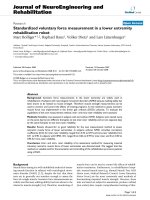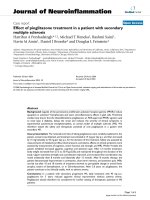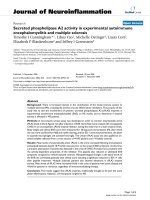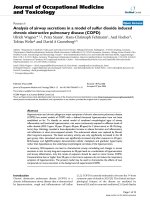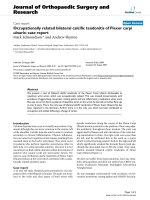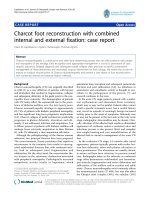Báo cáo hóa học: " Datura stramonium L. poisoning in a geophagous child: a case report" potx
Bạn đang xem bản rút gọn của tài liệu. Xem và tải ngay bản đầy đủ của tài liệu tại đây (155.82 KB, 3 trang )
CAS E RE P O R T Open Access
Datura stramonium L. poisoning in a geophagous
child: a case report
Asma Bouziri
*
, Asma Hamdi, Aida Borgi, Sarra Bel Hadj, Zohra Fitouri, Khaled Menif and Nejla Ben Jaballah
Abstract
Datura stramonium L. (DS) is a wild-growing plant widely distributed and easily accessible. It contains a variety of
toxic anticholinergic alkaloids such as atropine, hyoscamine, and scopolamine. Voluntary or accidental ingestion
can produce severe anticholinergic poisoning. We report an unusual case of DS intoxication occurring in a
geophagous young child after accidental ingestion of the plant. Our case is original because of the young age of
the victim and the underlying geophagia facilitating the occurrence of poisoning.
Introduction
Datura stramonium L (DS) is a hallucinogenic plant
widely found in urban and rural areas. Toxicity from
this plant, co ntaining tropane a lkaloids, manifests as a
classic anti-cholinergic poisoning [1,2]. Most cases of
DS poisoning reported in the literature occurred among
teenagers after voluntary ingestion of the plant for its
hallucinogenic and euphoric effects [1,3-6]. This report
illustrates an unusual case of DS poisoning occurring in
a geophagous 3.5-year-old child after accidental inges-
tion of the foliage of the plant with earth.
Case report
A 3.5-year-old girl was brought to the emergency
department by her parents for excitation, delirium, and
hallucinations occurring within the hour following
accidental ingestion of DS. Shehadamedicalhistory
of geophagia complicated by iron deficiency anemia,
which had been treated 6 months a go. The child had
the habit of eating earth, and she had ingested the
foliage of the toxic plant with earth, in the presence of
her mother, during a walk in the fields. On the initial
physical examination, her vital signs were: temperature
37.7°C, pulse rate 190 beats/min, respiratory rate
25 breaths/min, blood pressure 104/72 mmHg, and
oxygen saturation 99% on room air. Her mouth w as
dry. Facial and truncal skin was normal, and flushing
was not detected. She had a Glasgow Coma Scale
score of 11/15. She was agitated and aggressive with
purposeless movements, delirium, and hallucinations:
she saw wild animals, a man who wanted to beat her,
and various other things. Her pupils were widely
dilated and not reactive to light. The neurological
examination also noted hypertony with exaggerated
deep tendon reflexes, clonus of the feet, and tremu-
lousness. Meningeal irritation signs were not detected.
Abdominal distension and urinary retention were
noted. She was transferred to the pediatric intensive
care unit. Gastric decontamination with nasogastric
lavage and activated charcoal via a gastric tube was
rapidly performed after admission. Intravenous (IV)
fluids and diazepam (0.5 mg/kg) were administered.
The patient remained agitated and was given two more
doses of 0.5 mg/kg IV diazepam over the first 4 h of
hospitalization. The biological results showed normal
serum levels of urea, creatinine, glucose, Na, and K,
and calcemia. White blood cell (WBC) and platelet
levels were normal, but she presented hypochromic
microcytic anemia with a hemoglobin level of 7.8 g/dl.
Aspartate aminotransferase, alanine aminotransferase,
creatine kinase, lactic dehydrogenase, and gamma glu-
tamyl transpeptidase levels were normal. Prothrombin
time and INR were 76% and 1.1, respectively. The
clinical course was favorable. Repea ted neurological
examination revealed a gradual improvement of her
state of consciousness with disappearance of tachycar-
dia, mydriasis, delirium, and agitation. On the second
day of hospitalization, her neurological examination
was normal, and she was discharged home under oral
iron treatment.
* Correspondence:
Paediatric intensive care unit, Children’s Hospital of Tunis, Tunisia
Bouziri et al. International Journal of Emergency Medicine 2011, 4:31
/>© 2011 Bouziri et al; licensee Springer. This is an Open Access article distributed under the terms of the Creative Commons Attribution
License (http://creativ ecommons.org/licenses/by/2.0), which permits unrestricted use, distribution, and reproduction in any medium,
provided the original work is properly cited.
Discussion
Datura stramonium L. (DS) is a wild-growing herb
known as Jimson weed [1]. It also has several slang
names; the most common in our context is “sak el
ghoul.” T he whole plant, particularly the foliage and
seeds, is toxic bec ause it contai ns the tropane alkaloids
atropine, L-hyoscyamine and L-scopolamine, which are
responsible for anticholinergic syndrome resulting from
the inhibition of central and periph eral muscarinic neu-
rotransmission by these toxic components [1]. Causes of
DS intoxication include medication overdose, improper
preparation of edible v egetables, deliberate abuse as a
hallucinogen, use for homicide or robbery (we approve
this correction), and accidental intoxication [2]. Most of
the cases reported in the literature occurred among
teenagers after voluntary ingestion of the plant for its
hallucinogenic and euphoric effects [1,3-6]. To our
knowledge, our patient is the youngest case o f DS poi-
soning reported in the literature. The occu rrence of this
poisoning in our patient was f acilitated by an abnormal
dietary behavior called geophagia or pica, characterized
by a perverted appetit e for substances inappropriate for
consumption, such as clay and ear th [7]. Pic a can lead
to serious health complications such as iron deficiency
anemia, electrolyte and metabolic disorders, parasitic
infections, tooth wear, and intestinal obstruction. This
condition has been observed in men and women of all
ages and ethnicity , but is more prevale nt among lower
socioeconomic classes, pregnant women, and small chil-
dren [7]. Our geophagous child developed a typical form
of DS poisoning characterized mainly by a toxic delir-
ium occurring rapidly after ingestion. Typical symptoms
of DS intoxication are those of atropine intoxication,
which are dry skin and mucosa, flushing, mydriasis,
sinus tachycardia, hyperpyrexia, decreased bowel sounds,
urinary retention, and neurological disorders with ataxia,
impaired short-term memory, diso rientation, confusion,
hallucinations (visual and auditory), psychosis, agitated
delirium, seizures, and coma. In severe forms, respira-
tory failure and cardiovascular collapse have been
reported [1-6]. Rarely, rhabdomyolysis and fulminant
hepatitis have also been described [8]. DS toxicity
usually occurs within 60 min after ingestion, and clinical
symptoms may persist for 24 to 48 h because the antic-
holinergic effects delay gastric emptying, resulting in a
prolonged duration of action. Children have a special
susceptibility to atropine toxicity; even a small amount
may produce severe central ne rvous system manifesta-
tions [9]. Despite the y oung age of our p atient, a rap id
improvement of the neurological manifestations was
obtained, probably because the diagnosis was evident
and gastric decontamination was carried out soon after
ingestion. The diagnosi s of DS poisoning is essentially
clinical, but tropane alkaloids may be detected by gas
chromatography and mass spectrometry [1]. The treat-
ment is essentially supportive and consists of gastric
decontamination with activated charcoal by mouth or
tube, control of agitation with benzodiazepines, and
hyperpyrexia control (fluids and other cooling mea-
sures). Tachycardia usually responds to crystal loids [10].
Although physostigmine is the antidote for anticholiner -
gic toxicity, its use is controversial despite recent reports
of it being a safe treatment. Physostigmine is recom-
mended when the patient has severe agitation or psy -
chosis not controlled with bezodiazepines or h as
intractable seizures or tachydysrhythmias with hemody-
namiccompromise[1].Phenothiazinesforagitated
delirium s hould be avoided due to t heir anticholinergic
properties, and barbiturates can be administered in the
case of seizures refractory to benzodiazepines [1,10].
The prognosis of DS intoxication is usually favorable, as
in our case, but it may be fata l, especially during mas-
sive intoxications meant to be autolytic or the result of
toxicomania [6].
Conclusion
We report an unusual case of acute DS intoxication in a
3-year-old girl who presented with toxic delirium 1 h
after ingesting the foliage of the DS plant. Our case is
original because of the young age of the victim and the
underlying geophagia facilitating the occurrence of
poisoning.
Consent
Written informed consent was obtained from the
patient’s parents for p ublication of t his case r eport. A
copy of the written consent is available for review by
the Editor-in-Chief of this journal.
Authors’ contributions
AB, AH and AB drafted the manuscript, SBH and ZF participated in the
collection of the bibliography, KM and NBJ participated in the design of the
study and coordination of the manuscript. All authors read and approved
the final manuscript.
Competing interests
The authors declare that they have no competing interests.
Received: 22 June 2010 Accepted: 15 June 2011
Published: 15 June 2011
References
1. Kurzbaum A, Simsolo C, Kvasha L, Blum A: Toxic delirium due to Datura
stramonium. Isr Med Assoc J 2001, 3:538-9.
2. Chang SS, Wu ML, Deng JF, Lee CC, Chin TF, Liao SJ: Poisoning by Datura
leaves used as edible wild vegetables. Vet Hum Toxicol 1999, 41:242-5.
3. Arouko H, Matray MD, Bragança C, Mpaka JP, Chinello L, Castaing F,
Bartou C, Poisot D: Voluntary poisoning by ingestion of Datura
stramonium. Another cause of hospitalization in youth seeking strong
sensations. Ann Med Interne 2003, 154:S46-50.
Bouziri et al. International Journal of Emergency Medicine 2011, 4:31
/>Page 2 of 3
4. Spina SP, Taddei A: Teenagers with Jimson weed (Datura stramonium)
poisoning. CJEM 2007, 9:467-8.
5. Wiebe TH, Sigurdson ES, Katz LY: Angel’s Trumpet (Datura stramonium)
poisoning and delirium in adolescents in Winnipeg, Manitoba: Summer
2006. Paediatr Child Health 2008, 13:193-6.
6. Djibo A, Bouzou SB: Acute intoxication with “sobi-lobi” (Datura). Four
cases in Niger. Bull Soc Pathol Exot 2000, 93:294-7.
7. Khan Y, Tisman G: Pica in iron deficiency: a case series. J Med Case Reports
2010, 4:86.
8. Ertekin V, Selimoğlu MA, Altinkaynak S: A combination of unusual
presentations of Datura stramonium intoxication in a child:
rhabdomyolysis and fulminant hepatitius. J Emerg Med 2005, 28:227-8.
9. Al-Shaikh AM, Sablay ZM: Hallucinogenic plant poisoning in children.
Saudi Med J 2005, 26:118-21.
10. Rodgers GC Jr, Von Kanel RL: Conservative treatment of jimsonweed
ingestion. Vet Hum Toxicol 1993, 35:32-3.
doi:10.1186/1865-1380-4-31
Cite this article as: Bouziri et al.: Datura stramonium L. poisoning in a
geophagous child: a case report. International Journal of Emergency
Medicine 2011 4:31.
Submit your manuscript to a
journal and benefi t from:
7 Convenient online submission
7 Rigorous peer review
7 Immediate publication on acceptance
7 Open access: articles freely available online
7 High visibility within the fi eld
7 Retaining the copyright to your article
Submit your next manuscript at 7 springeropen.com
Bouziri et al. International Journal of Emergency Medicine 2011, 4:31
/>Page 3 of 3

